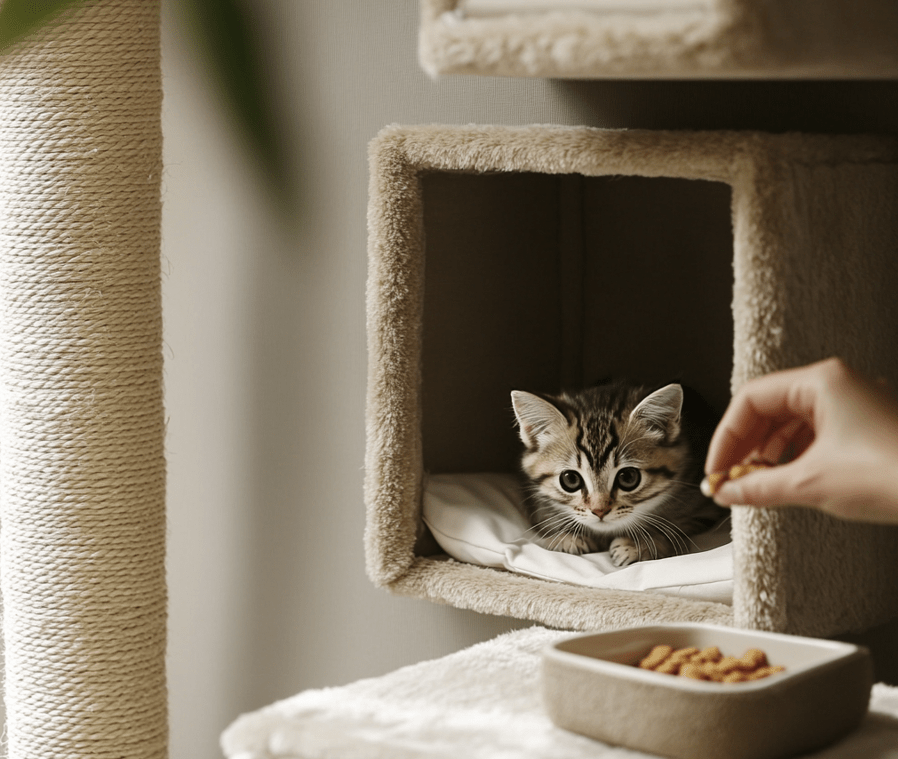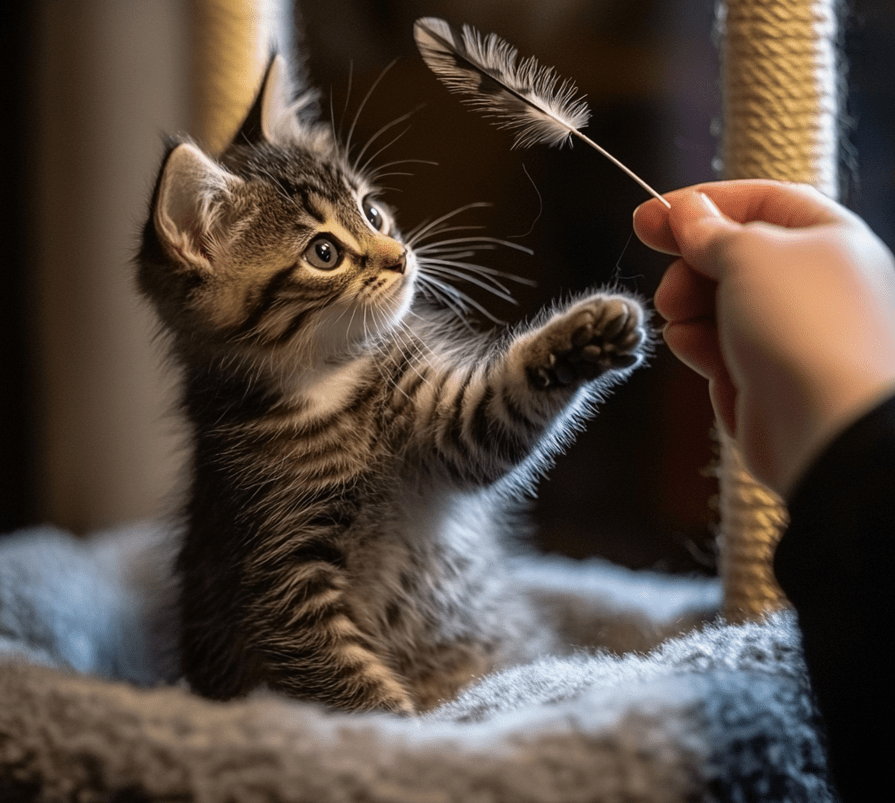
When you bring a shy kitten into your home, making him friendly becomes a very important and challenging task. You can make your shy kitten more friendly by following some steps. Then your kitten will like you and adapt to your environment very well.
What will you need?
Patience
If you want to socialize a shy kitten, you need a lot of patience. A cat’s instinct is to pet its owner slowly at its own pace. However, young cats or kittens can be socialized faster than adult cats. You must allow the kitten to socialize at his own peace, but never expect too quickly.

Routine
You should play with your shy kitten at the same time every day. This will make him expect your presence regularly and develop a habit of spending time with you. An environment that kittens like makes them more friendly. But when something unexpected happens they will feel very insecure and become more afraid or aggressive.
Frequency
You need to visit your kitten frequently for the first few weeks. A five minute exciting session with a shy kitten everyday gives very good results. It is perfect if cats are able to see and hear humans around. A cage in a living room of home is better than that quiet bedroom where the cat hardly ever sees anyone. If the cat is in a quiet environment, leave a talked radio and t-shirts you wore that week inside her cage. This will let him smell what you are using.
Confinement

Shy kittens should be confined to a cage or small room where there are less hiding spaces. This will speed up their taming process. Your kitten should be positioned at your waist height. Then he won’t be threatened by your height. You can decorate your room with a cat tree. This will allow your kitten to climb up on it. Block of hiding places in your room such as under the bed. Otherwise your shy kitten will hide in these places and you won’t be able to socialize them. A partially covered bed or a cardboard box can be kept for your kitten. This will make him feel secure.
Isolation
It is also advisable to keep the kitten isolated from other cats because feral kittens typically will bond with another species. And you do not want them coming home; they no longer need or require human comfort. If you can separate them for some weeks, they will still love other cats once re-integrated. The kitten must begin to associate humans with food, safety and adoration.
A Step-by-Step Plan:
Day 1: Bringing the kitten Home
When bringing a shy kitten into your home, keep them in a very small space. They may get scared when they see a big room. The room to keep them should be quiet. No other animals or children are allowed. First, only go into the cat for personal necessities such as food/water and litter box. Food plays an important role to make the kitten pet. So make your shy kitten friendly to let him know that you are for him and are aware of his needs. During this time you can also talk with your kitten very slowly and softly, as it will be another way of being used to you and your voice. And move around the kitten slowly every time.
Week 1: Trust Building
After the initial hand over, try to sit with him as many hours a day he will allow. Don’t try to pet the cat yet just sit nearby and talk to him. When you go back to get more practice, also try moving just slightly closer each time and watch for his signals. Just make sure you leave whenever the cat signals that it wants to go away. Never push. Let the cat take her choices and go at its own rate.
Week 2-3: Touching

- Approach the shy kitten only after he seems at ease with you hanging around him. You might wear a long shirt or gloves in case you get scratched. At first, when you begin to make a move at the kitten, then move your hand very slowly letting it smell on your hand before touching him/her. If the kitten appears to be calm, pet it gently. Again, don’t push him anymore. Take it nice and easy; pet the kitten for a minute or two on day number one, moving up to even more time. Stop whenever the kitten appears angry or fearful. Oh, and don’t forget that kittens are usually very touchy about their paws and tail/rear end so I recommend you avoid these areas at first.
- Here’s what to do if your kitten doesn’t like to be touched: Before you touch him, offer him some tasty treats like tuna fish or chicken. Then you can tie a cloth to a stick and hold it in front of him to play.
Cats that aren’t ready to be touched: Start with a feather wand or pole toy, then use the stick end and wrap a piece of soft flannel around it to touch. Start by lightly placing the stick right over the back of your cat’s neck very lightly and delicately begin stroking the back of his neck and moving to rub overhead. Gently stroke the top of head, stay away from ticklish areas (like sides). When you’d like to pull the stick out (after a minute or so every day), bring one hand down and just touch it as though an extension of your arms. Repeat but do this 3-5x per daily use, by doing that maybe over days move your primary give lower quickly back into they relax near kitty when rubbing softly. Now you can finally pet the cat with your hand. While you touch the cat, have a toy or food with which to distract Distract your hand around behind his head. Do not go up to your cat’s face with our hand; slip it around behind using the stick as a cover. Try rubbing the back of its head and neck, but only go on to other parts after you have stopped biting. When the cat seems to be enjoying this, you are on track!
Week 4: Holding
When he/she is comfortable with long contacts and seems OK to involve the touch, you can try to hold a cat. If you are patient, allow the cat time to get used to being hugged and sitting on laps by first forcing him or her into a short hug. If he/she does well with this, and seems comfortable exploring in the room with you, then perhaps it is time to show him/her other parts of your house or introduce them to another animal. It might be a good idea to try playing with the cat too.
Tips:
1.Speak and move slowly & gently; avoid high-pitched noises.
2.Do not establish prolonged eye contact, look at the floor to one side
Keep an eye for the body-language and give her room if she is growling, hissing or wagging tail
Do not extend your fingers towards your cat, as doing so makes you look like claws ready to strike back at the cat.
3.Offering the occasional treat never hurts and might even win a few feline friends. Some may get aggressive and just try to “scare” the food out of you by lunging or spitting. For the cats where treats don’t work so well in this case, just do not use them. Begin with food you can place at the front of her space, from hand feeding kibble or small pieces of cooked deli meat to bits for tuna. Once she gets comfortable enough eating in your presence, try having that same snack nearer and near one hand is on stand by as shut because feline will assist become accustomed to contact. Rub his body with the stick while eating the treat and if he allows that, rubbing your hand
How to introduce a shy kitten into our home

You got the cat bonded with you and now it’s time to introduce a new furry mate for other people in the house.
If family members have not already been in the room, bring them in and speak to your cat while playing with him using either string or a wand. Of course, at first he will shy away from strangers and not play ball with them until later, but believe me, love for him will be played in his hands. Your other cats know what is going on. This can make them smell the scent of a new cat.
Assuming your foster cat is medically cleared to be around other cats in the household, start by smelling each other by exchanging bedding between them. Personal blankets need to be mixed by rubbing the cats over with each other. Fit a screen door or other strong, but secure barrier through which both sets of cats will be able to observe and one set learns from the actions of another. In the presence of said new cat, interact with your pets more than you usually would; pick them up, love on them and then put them back down. Allow the new cat to watch your cats and how much they love this.
First things first though, make sure the rest of the house is cat-proof so he/she doesn’t escape or get into any mischief. Choose where the cat may roam and which rooms will remain closed, since it can become overwhelmed at having access to all areas of the house in one go. To start with, he will be branching out through the rest of the house to check it all out for alternative spots. When he has gone back to his room or is in some other “safe spot” where you keep him, work with him during that time – it goes hand-in-hand with taming and socializing.
Soften your voice whenever you move near some of his hiding spots if he keeps to yourself and sneaks everywhere. Do not force him out of these hiding spots, although you can try to entice him with food or toys. As he continues to investigate and discover more of the house, you can then gradually leave others accessible. Move the cat’s litter tray, food and water out of its original room slowly to encourage it to full-time spend time in the rest of your house. While initially he may not want to come near you during the day, night-time out again and placing a pushing food bowl morning meal, together with rewards will gradually tempt him out during daylight hours.
Adopting out a tamed or rehabilitated shy kitten

For any cat rehoming is a traumatic event, to be settled twice in one lifetime must add up as the ultimate brain scratcher even for an ex heathen wild animal becoming a human housecat. Socialization has to be reinstated in the new home if they are going to adopt out that cat including keeping it locked away so that it can become close with its potential owners and able to wander around their house at night-time. There will be hiccups but as a rule, the process normally goes faster second time since kitty has learned much about humans and living with them/u surroundings.
This time I am learning how to use this knowledge in a new environment. Socialized feral cats should go into a home that has at least one fully socialized, cat-friendly household since he will not only gain much knowledge of observing his tame feline companions. The new owner needs to be prepared to do the work you have been doing over and over again.
The new owner should have spent a lot of time in your home getting to know the cat first because the bond needs to quickly move from you to them.




